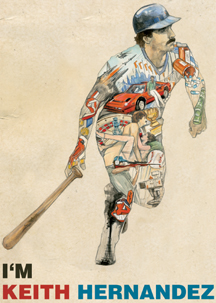My Michael Jackson post prompted some Facebook-based reminiscence from my friend Tim, recalling the junior high school Saturdays in which we’d head down to Crossroads Mall in Salt Lake City to spend our allowances on records. I do remember one time we went off the beaten path to the distinctly Mormon-flavored Sam Weller’s Zion Bookstore where during a previous drag of a visit with my mother, I had discovered a book about baseball cards. With that in mind, I guess that particular week I’d refrained from excavating whatever British Invasion landmark album I’d been curious about, because I had no hesitation to shell out $8.95 for The Great American Baseball Card Flipping, Trading and Bubble Gum Book.
Alternately hilarious and poignant, that book quickly became one of my all-time favorites; hell, I’ll put it with The Summer Game and Ball Four on my shortest of short lists of baseball books. Two decades later it would become one of the initial inspirations for this site, albeit one I’ve invoked with decreasing frequency as my own work here and beyond has grown more analytical.
I’m reminded of all of this because of a Los Angeles Times article linked by Cardboard Gods‘ Josh Wilker, a man who adopted the book’s style of incorporating baseball cards and the existential revelations they held into the narrative of his own journey. In it the LAT writer catches up with the authors of TGABC… — that thing just doesn’t want to condense — Brendan Boyd and Fred C. Harris:
Boyd and Harris were twentysomething baseball geeks who worked together at a Boston bookstore. The idea, Boyd remembers today, came when a customer requested a book about baseball cards and he and Harris realized that there was none. After the store manager, Richard McDonough, left to become an editor at Little, Brown, he signed the pair to write their baseball card bookAt once irreverent and nostalgic, “Great American” is a hybrid of Roger Kahn’s “The Boys of Summer” and Mad magazine. The first section is devoted to Boyd’s memories of collecting cards in the 1950s and early 1960s, at “corner stores that were never on corners. Variety stores completely lacking in variety. They were generally owned by middle-aged men with psoriasis — paunchy citizens with sallow complexions and sour outlooks, who wore plaid woolen shirts no matter how hot it was and little felt hats that had repeatedly been stepped on.”
…Boyd went on to contribute the text for “Racing Days,” a book featuring Henry Horenstein’s exquisite horse racing photography. He also wrote the novel “Blue Ruin,” about the fixing of the 1919 World Series. He was a pop music and financial columnist. Today, he is working on another novel.
“I’m proud of the baseball card book, but it feels like it was written by a different person,” he says. “A lot of people thought I was interested in baseball cards, but I was really interested in the cards as a way of talking about childhood.”
Harris owned a store in Boston called the Great American Baseball Card Company until, he says, “baseball cards stopped being about fun. The whole money motive got disgusting.” He now works in IT analysis and writes a blog.
The article also has a few choice quotes from Terry Cannon, the executive director of the Baseball Reliquary, even drawing a line from the book to the Pasadena-based Reliquary’s intersection of baseball and art, including their upcoming exhibit, Cardboard Fetish. Good stuff, though a part of me wishes Boyd and Harris had more baseball writing in them than just that one tome.
I guess it’s up to the rest of us now.

